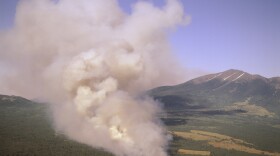The world’s largest ponderosa pine forest stretches from the San Francisco Peaks to the Arizona/New Mexico border, but now this forest is overgrown and threatened by huge fires.
In the third part of our series on the Four Forest Restoration Initiative, Michael Collier reports that collaboration has been essential in dealing with the threats to the forest.
“It’s kinda like making sausage, it’s messy. But the output’s good, right?” That’s how Dick Fleishman, 4FRI assistant team leader, describes the collaboration that has been integral to the process. Maybe thirty people attend a given meeting of the stakeholders, often ones you would not expect to find in the same room. They are scientists, environmental groups, government employees, the occasional politician. All bring a rich diversity of ideas and ideologies. Their histories of working together—and against each other--stretch back over decades.
Todd Schulke is one of the founders of the Center for Biological Diversity, an environmental group known for fighting lots of timber sales. Schulke met logger Dwayne Walker fifteen years ago in eastern Arizona. Walker learned restoration forestry on the White Mountain Stewardship Project, a smaller effort that’s now a prototype for 4FRI.
Schulke chuckles when he thinks of his and Walker’s relationship. “Yeah…Dwayne and I we go back a ways now. We’re unlikely allies but we’re strong allies.”
And Dwayne Walker says of this strange bedfellow: “I got a good relationship with Todd Schulke and that. We’ve joked about it; sometimes he says ‘I never believed I’d be riding around out in the woods with you.’ First time he said he didn’t know if he’d be coming back from the woods.”
Walker adds, “The idea that you can go out in the woods and shake hands with somebody you know and work problems out is a compelling way to think about getting these controversial things done. I know this big world of ours; you got industry on one side, you got the nay-sayers and hen-peckers on the other. What has to happen for everybody is to come to the middle.”
But it’s not always that easy. Henry Provencio of the Forest Service is team leader of 4FRI. He finds the issue of trust at the heart of the process. “I’ll be perfectly honest…I struggle with it. My kind of thing is I’ll trust you ‘til I don’t. I think we work real well collaboratively on some issues when maybe the stakes aren’t so high. I think we all--agency, private, local governments--struggle with what it means to collaborate.”
Taylor McKinnon also works with the Center for Biological Diversity. He is frank in his assessment: “I don’t think it’s useful to operate on a premise of trust. I think it’s much more useful to operate on a premise of agreement. Because I don’t trust the Forest Service and I never will. But I can forge agreements with the Forest Service and other stakeholders about what we need to do to move forward.”
And moving forward is the name of the game. Marcus Selig of the Grand Canyon Trust sees some limits to what can be done by the group. “Because we’re a diverse collaborative,” he says, “we can’t have a position on every issue. But what we can reach agreement on is that the forests need to be treated, but the detail of that is more difficult. The collaborative only has so much power. The final decision on what the forest looks like rests in the Forest Service’s hands.”
The collaborators all agree that old-growth trees are off the table. The Forest Service plans to release 4FRI’s first environmental impact statement in early 2013. The document will address the hotly contested issue of big trees—not always old, but big.
Pat Jackson, chief of staff for the Forest Service’s Southwest Region, talks about how his agency sees the issue. “The collaborative put together a large-tree retention strategy, basically what that strategy did is lay out some certain circumstances that if those were met then large trees could be taken, trees over 16 inches in diameter. And what the forest did is say but that isn’t exception categories, that is the rule.”
Environmental groups warily agreed that some large trees might need to be cut under certain ecologically justified cases, but they’ve been reluctant to concede that these circumstances are found widely across the forest.
“There’s this deep level of distrust of the Forest Service that runs almost in our genes,” admits Todd Schulke. And because of that, he says “one of those possible outcomes is litigation. It’s never going to be off the table. Litigation is really background noise. It happens, it’s not fatal typically. On the other hand, we’ve put a lot of time and energy into 4FRI; we want it to succeed.”
Everyone wants 4FRI to succeed, but everyone also knows it’s a grand experiment.
This series on 4FRI is funded in part by the Grand Canyon Trust.








